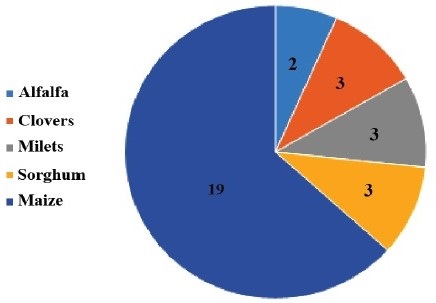The department of maize and forage crops research was established in 1970 in order to develop and improve hybrid maize cultivars in cooperation with Zemon Polje breeding institute in Yugoslavia, so that 20 Iranian along with 7 Yugoslavian experts commenced their activities by working on agronomic, breeding, seed production programs and combating/preventing pests, diseases and weeds. In this regard, scientific studies and activities related to the cultivation and development of maize farming in Iran, scientific experiments and introduction of new machinery in order to mechanization of cultivation, care and harvesting of maize, breeding and preparation of hybrid seed, as well as identification of cultivars that are adapted to Iranian climate conditions have been taken into account.
Regarding forage crops research, initially alfalfa research activities were assigned to this department, but in 1984 the research section of forage plants and in addition to alfalfa, committed in clover, sorghum, sainfoin, millets and other forage crops research. In line with AREEO's policies, these two sections were merged in 1998 and the Department of Maize and Forage Crops research was established. Now, in order to achieve its research objectives, 62 experts and researchers from all over country have been involved in research projects in different fields such as maize, sorghum, alfalfa, clover, millets, sainfoin, vetch, and sulla. This department also works collaboratively with other foreign and international institutes and research centers, such as CIMMYT/Mexico, ICARDA, ICRISAT, Novi Sad, and the Lokianenko Institute in Krasnodar, Russia.

In order to reach seed corn self-sustaining and developing seed corn cultivation in the country up to 415,000 hectares and achieving the yield of 8.5 tons per hectare, conducting basic and applied researches are inextricable and inevitable. Therefore, the Department of Maize and Forage Crops Research is required to conduct research programs to produce and introduce new cultivars adapted to the climatic conditions of different parts of the country. Total number of cultivars introduced by the Department of Maize and Forage Crops Research after the Islamic Revolution is depicted in Figure 2.

Figure 2. Number of released cultivars by Department of Maize and Forage Crops Research in 1979-2019.